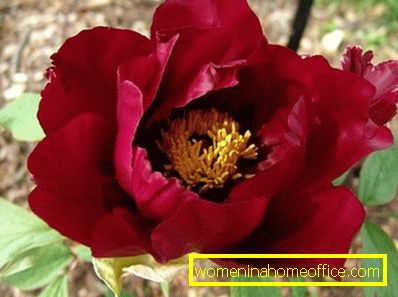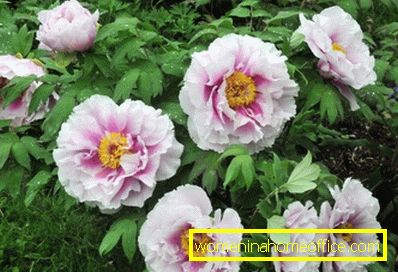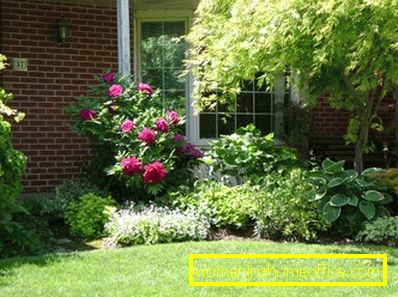Tree peony
Peonies have long been competing for the title of the most beautiful flower with roses, but most gardeners correctly distribute roles between them: if a rose, being a woman, a queen, then a peony, as a man, can be considered a king. These lush, voluminous buds conquer the passer-by, and more and more often tree-like peonies of various varieties can be found at the dacha plots even in the coldest corners of the country.
Tree peony: varieties and flower photos
A distinctive feature of the tree peony from its grassy counterpart is a long wait for flowering, the period of which, in addition, is very short: the bushes begin to cover with buds only at 9-10 years of life, and buds open only for 1.5-2 weeks. However, we love tree peony not only for flowers, but also for decorative fruits, and even for attractive foliage. This shrub can be used as a green hedge, occasionally covered with flowers, since its height (up to 1.5 m) allows the plant to be used as a rather dense fence, although it needs a support and a garter.




- Peony Delyaveya - the highest of all species of tree peony, whose stems are pulled out by 2 m. Up to 4 buds can develop on each shoot, flowers in diameter vary from 5 to 10 cm. Petals are made in a rather unusual chestnut range, they are revealed in mid june. This variety is loved for good rooting when grafting and a high degree of germination of its seeds, which makes it possible to reproduce the tree-like peony without problems. The yellow peony related to it has smaller flowers (up to 9 cm) with flowers with yellow or yellow-red petals. Both species are combined into a single group, from which varieties are derived through interbreeding with grass peony.
- Chinese-European species of tree peony are distinguished by their fluffy ball-flowers, which are known to most flower-lovers. Among them are the most grown varieties "Maria", "Moscow University", "Garnet Bracelet", "Blue Doe" and "August", the breeding of which is a merit of Russian botanists.
- Japanese species of tree peony have lighter, delicate flowers, among which there are both semi-double and no terry options. The most popular varieties of "Akron" (carmine-red), "Christine" (white), "Largo" and "Kinsui" (the traditional pale pink color), "Walter Manes" (claret buds).
But today, no less, you can count and hybrid varieties, so if you want, there will always be even transitional between Japanese and Chinese-European species of specimens. For example, spherical large (up to 16 cm) flowers of the varieties "Rhapsody" or "Snowmountain". The height of the bushes varies in values from 80 to 100 cm.
Planting peony and care in the open field


Peony bushes are planted in mid-March or in winter, in October and early November. Depending on the age of the plant, the hole under it is dug out to a depth of 20 to 50 cm, its width is always equal to the depth. Moreover, if the bush was planted, the depth should be increased by another 5-10 cm, in order to deepen the vaccination zone. A bit of compost can be added to the bottom layer of the well, although the nutritional value of the soil for the tree peony is the last point the plant will pay attention to. Much more useful to him is a layer of gravel, broken brick or coarse sand. It is necessary to make an earthen mound near the trunk, which is slightly compacted, tightly adjacent to it: here in a few years new roots will appear.
Since the tree peony is able to grow without transplants up to the age of 20, it should immediately pick up the right place. Best of all, if this is a zone in which water does not stagnate, therefore the lowlands immediately disappear. In this case, one cannot allow a neighborhood with tall trees and buildings. Tree peonies grow and develop well in shaded areas, and with active sun they create fabric canopies. The plant feels fine and not too dense loam, barely diluted with gravel, and on the ground, dominated by sand and pebbles. It is important that the earth is often loosened, to preserve air exchange, and remain in a slightly damp state.
The main reason for the active cultivation of tree peony in the middle lane is its incredible resistance to frost. Of course, in the harsh, snowless winter, bushes arriving from Asia, which barely sees snow, need shelter. However, by accidentally freezing the root system of the plant will not die, and the flowers will not fly around at the same moment: before the cold, the bush will only lose its foliage. The conditions for the preservation of the bush itself depend on the area in which it is grown: in the European part of Russia, tree peonies do not even mulch for winter, but practicing gardeners still advise warming the roots with spruce fur trees, and also cutting off the bushes along their upper third.
Among the pests of the tree peony, only ants are seen, actively attacking the bushes, as soon as the buds begin to prepare for opening. As the comments of experts show, it is difficult to fight this scourge - folk methods, for example, the same tincture of onion peel, help for a short time, and it is unwise to resort to chemical preparations. Crows are also occasionally seen, causing damage to the roots of the tree peony, but in order to protect them, it is enough to cover the ground around the bush with any material for mulching in a dense layer.
Other nuances of tree peony care are no different from those that are characteristic of any ornamental plant: from time to time the bushes are watered down to the root, and 2-3 times over the summer they need to have a scattered shower with a hose to refresh the leaves and shoots. With an excess of weeds, weeding is done, although rare weeds can prevent the growth of shrubs. Feeding the tree pion is practically unnecessary, and at the end of summer they are even dangerous: it is enough to introduce mineral fertilizer in the spring so that the bush gets the optimum amount of nutrients for it. Pruning is done in the spring and only for the sake of removing the dead shoots, and in the first year of the pion’s life, it is necessary to remove the buds that are tied, which he cannot “feed” to full-grown flowers.
Growing a tree peony is not the easiest process, although the flower is quite independent and frost resistant, which allows it to be planted even in cold areas of the country. At the same time, not all gardeners are pleased with the long period of waiting for the peony to bloom, which is why experts recommend planting its cuttings with grassy peony - this will allow you to see the buds opening much earlier.